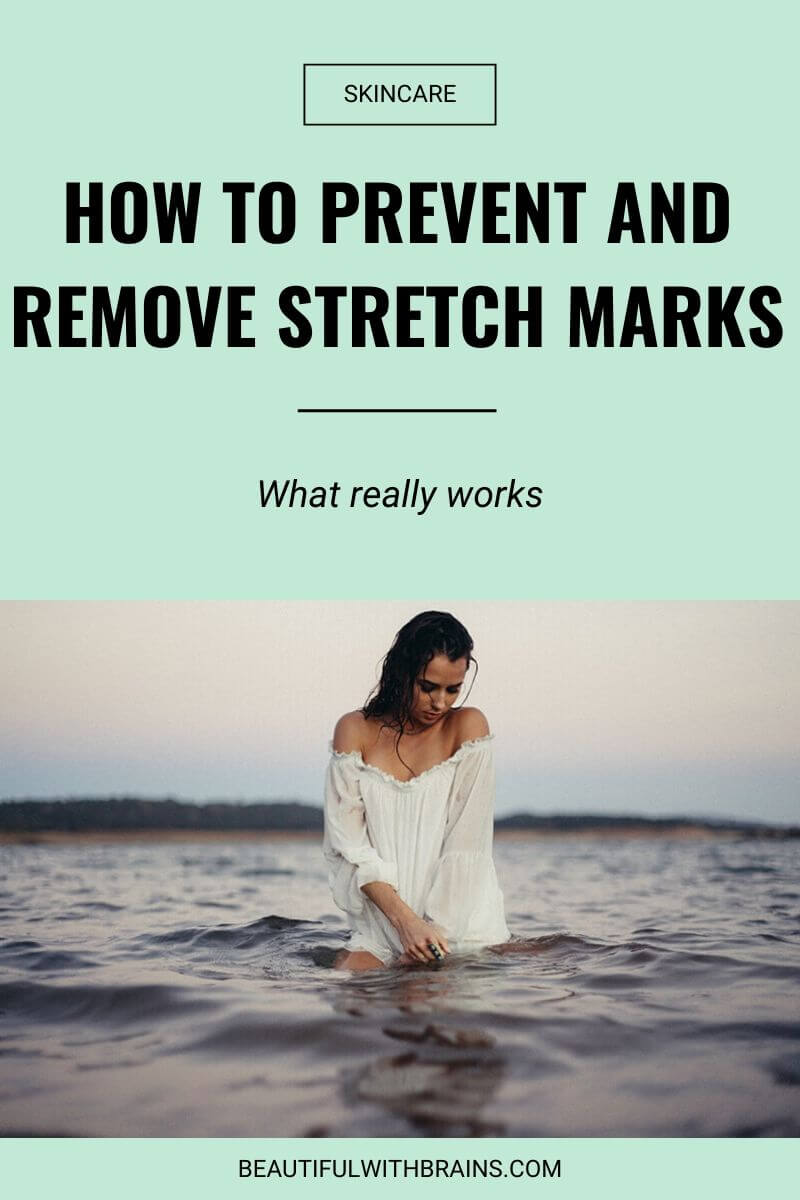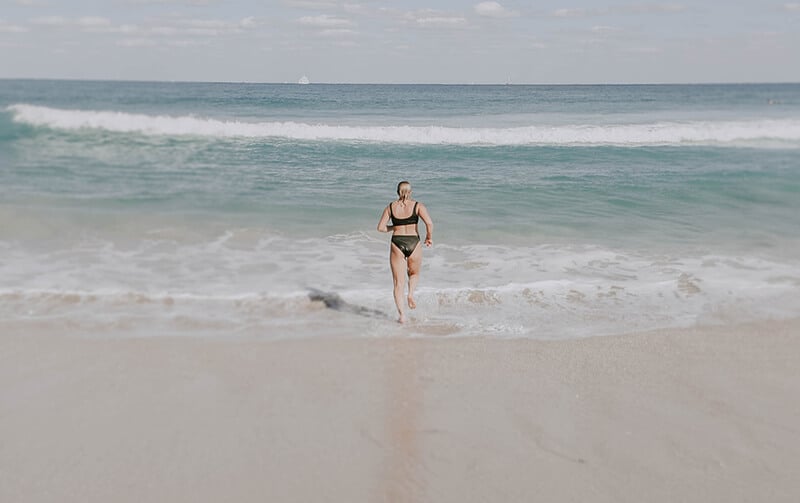
Stretch marks are like pimples. They appear at the worst of times.
Like puberty. I had finally managed to shed off the extra pounds I had put off during a couple of rough years at school (don’t ask), only to have my excitement ruined by the unsightly stretch marks that now graced my thighs and bum.
Or pregnancy. It’s one of the most magical moments of your life, but the stretch marks are almost a done deal that makes new mums feel super self-conscious.
It’s easy to say stretch marks are not a big deal. In the grand scheme of things they aren’t. I’d take stretch marks over being fired any day, for example.
But for years, stretch marks affected my confidence so much, I refused to wear miniskirts or – heaven forbid! – a bikini at the beach. Heck, I avoided the beach completely. Sad, I know.
These days, things are different. It took a lot of time, tears, and compassion, but I’m finally comfortable with my body – stretch marks and all.
But I’d lie if I said I wouldn’t jump at the chance to get rid of them (because you can be ok with something and still not want it in your life).
Is it possible? Can you really remove stretch marks completely and get your smooth skin back or can you only improve their appearance somewhat? Let’s find out:
What Are Stretch Marks?
First things first: what are stretch marks? (Cos you can’t fight an enemy if you don’t even know what it is).
Stretch marks are a type of scarring. They’re very easy to recognise. They look like long, narrow streaks (or lines) and can be pink, red, brown, black, silver or purple. Their colour usually fades away overtime.
Stretch marks develop when skin is stretched too quickly. It all happens in the deepest layers of your skin, so you don’t get a cut or bruise.
You see, your skin has three layers:
- Epidermis: The most superficial layer of your skin.
- Dermis: The second layer of your skin, where most of your collagen and elastin proteins reside.
- Hypodermis: The lowermost layer of your skin, it’s mainly used for fat storage.
When there’s a tear in your dermis layer, the Hypodermis is literally poking through to the top layer of your skin and becomes visible. That’s a stretch mark.
Anyone can develop stretch marks, but they’re common in women. 90% of us have it, ladies. You’re definitely not alone.
They’re also more common in certain areas:
- Breasts
- Bottom
- Chest
- Hips
- Thighs
- Upper arm
Bad news: stretch marks are permanent. You can reduce their appearance, but they never fade away completely.
Need help creating an anti-aging routine that really works? Sign up to the newsletter below to receive the “Anti-Aging Skincare Routine Cheatsheet” (it includes product recommendations, too!).
Why Are Stretch Marks Often Red?
Have you noticed that when stretch marks first appear, they’re often a bright red colour? There’s a reason for that.
Remember when I told you stretch marks are bits of Hypodermis showing through the fracture in the dermis? The Hypodermis is full of blood vessels. Blood is red.
It’s a bit like getting a cut, only with no pain or blood flowing out of the wound. You just get a glimpse of what’s underneath the surface.
As time passes, and your stretch marks get old, that bright red colour turns to silver. Why? Silver is the colour of scars. That’s just what’s happening to your skin now.
(FYI, as their colour fades, stretch marks can also be pink, purple, white…).
Fun fact: bright red stretch marks are easier to treat than silvery/white streaks. Makes sense. The older they are, the harder the scar removal job.
What Causes Stretch Marks?
You wanna know the real reason stretch marks are so hard to remove? No one knows what’s causing them…
All we know is that stretch marks appear during periods of growth, such as:
- Pregnancy
- Puberty (because your life doesn’t suck enough already…)
- Steroid therapy
- Sudden weight gain
- Sudden weight loss
Stretch marks can also be a result of certain diseases, like anorexia, tuberculosis, and Cushing’s disease.
Oh, genetics play a part, too.

How Do Stretch Marks Form?
Stretch marks happen when skin is being pulled too far in opposite directions.
Skin is usually pretty elastic. Thanks elastin for that. It’s a protein that makes sure your skin bounces back after you pull it. But just like an elastic band snaps with overuse, elastin production is disrupted when skin is overstretched.
That’s exactly what rapid weight gain or loss does to your skin. The elastin in your skin snaps, giving you stretch marks.
Can You Prevent Stretch Marks?
Stretch marks are so hard to treat, it’s better to prevent them when you can. But can you?
The internet is full of stretch marks prevention treatments that are supposed to keep these reddish stripes off your skin. Like coconut oil. Bio Oil. All kinds of oils. Or massages. Or hyaluronic acid creams like Alphastria.
Anything moisturising basically. Common sense says that if you keep your skin well-moisturised, you can prevent tears and stretch marks.
Science isn’t on board yet. Truth is, there is no proof anything – moisturising or not – works. Studies tested, as a preventative measure during pregnancy:
- Alphastria
- Cocoa butter
- Olive oil
- Trofolastin
- Verum
The results? “There was no statistically significant average difference in the development of stretch marks in women who received topical preparations with active ingredients compared to women who received a placebo or no treatment.”
Other studies are a bit more positive. There is some small evidence that Alphastria and Trofolastin may be onto something:
- Alphastria: “One randomized controlled study demonstrated that 10% of women in the treated group compared with 70% in the placebo group developed” stretch marks. The active ingredient is hyaluronic acid, which stimulates the production of collagen.
- Trofolastin: “56% of subjects in the placebo group compared to 34% in the treatment group developed SD [stretch marks]. Additionally, in women who had a history of SD during puberty, the treatment cream gave 100% prevention of SD, compared to 89% in the placebo group.” It seems to work thanks to Centella Asiatica, a plant with anti-inflammatory properties that stimulates fibroblasts and boost collagen production.
If you know you’re going to gain or lose a lot of weight fast, using Alphastria or Trofolastin to prevent stretch marks is your best bet. But they don’t work in 100% of cases.
Give them a try, but don’t get too bummed out if they don’t work.
Related: The Complete Guide To Hyaluronic Acid: What It Is, What It Does, And How To Use It

How To Remove Stretch Marks
There’s no cure that’ll get rid of stretch marks completely. But, there are some treatments that can help reduce them:
- Glycolic acid peels: Daily application of 20% glycolic acid can improve the appearance of stretch marks a little. But in this study, they were used together with L-Ascorbic Acid (Vitamin C) and tretinoin, so it’s not clear how well glycolic acid works alone.
- Laser: Some laser treatments (especially fractional photothermolysis using Fraxel lasers) could help reduce stretch marks. Multiple sessions are necessary to see results. Keep in mind that most laser treatments aren’t suitable for darker skin tone. Talk to your doctor to discuss the best treatment for you.
- Microdermabrasion: There’s some evidence it’s as effective as Tretinoin to reduce stretch marks.
- Tretinoin: A form of Vitamin A so powerful (and harsh!), it’s available by prescription only. Applying a 0.1% concentration every day for 6 months “reduced length and width of SD [stretch marks]… No significant difference in dermal collagen and elastic fibres in treatment compared to placebo.” Even then, it works only on new stretch marks. FYI, lower concentration of Tretinoin didn’t work as well. That makes it unlikely that OTC retinol creams and serums help with stretch marks, too.
- Trichloroacetic acid peels: Monthly 15-20% diluted TA peels can improve both the texture and colour of stretch marks.
Even though there are so many treatments for stretch marks, nothing seems to work better than the rest or get rid of stretch marks for good.
How To Reduce The Appearance Of Stretch Marks
If you can’t get rid of stretch marks, hide them. Here are a few options:
- Concealer: Just like you’d hide a pimple or a brown spot, you can use concealer to cover up the stretch mark and make it look less obvious.
- Exercise: When your body is toned, skin looks smoother and less bumpy. It doesn’t really matter what type of exercise you do. Dance, running, tennis… Just get that body moving, baby!
I know, I wish there were better options, too!
But the best thing you can do is to accept your stretch marks. Almost every woman has them – even Angelina Jolie!
Remember: you are NOT your stretch marks. You’re so much more than that. You’re smart. You’re funny. You’re kind. You’re caring. You’re an unique human being with skills, passions, and traits no one else has.
Celebrate ALL that you are. Stretch marks or not, you ARE beautiful.
Will Stretch Marks Fade?
Stretch marks will fade colour overtime. But there’s no cure for them or any treatment that will prevent them for sure. The best you can do is keep your skin toned and moisturised and embrace your stretch marks for what they are: an annoying fact of life that aren’t worth thinking about.
How do you prevent and remove stretch marks? Let me know in the comments below.
